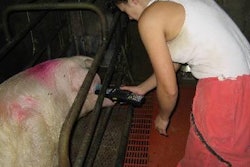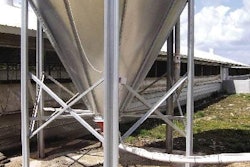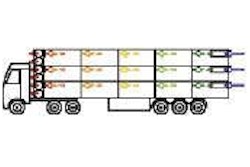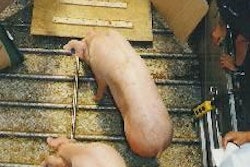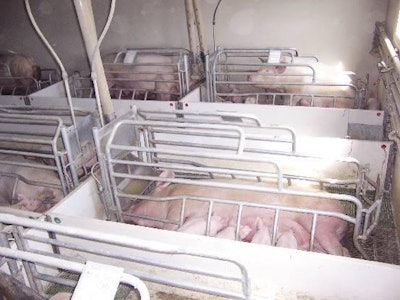
Bigger sows weaning larger litters in modern production systems bring a need to look again at the design of places of birth. This international review process is extending to the provisions for controlling the climate inside the house as well as to the details of pen layout and facilities.
To give an example from Denmark, herd managers there have been advised to be aware of the extra ventilation needed in a maternity house operated all-in/all-out by room for batch farrowing and later weaning alongside high sow productivity. Previously, the heat produced by sows and piglets in a housing section operating continuously up to a weaning age of 4 weeks was reckoned to amount to about 800 Watts per farrowing pen. A changeover to farrowing in batches and weaning at 5 weeks could involve a heat production of 1250 Watts per pen once an increased sow weight and the effects of more and larger piglets were taken into consideration, according to a bulletin from the national industry organisation now called Danish Pig Production (DPP).
The key implication from this additional body heat is expressed in terms of the maximum ventilation rate necessary for each pen. The advisers suggested that this maximum rate would need to rise from 250-300m³ to 400m³ in order to maintain reasonable conditions for temperature and humidity. At the other extreme the same source has cautioned against uneven heat distribution during cold weather, in a farrowing section that has a diffuse air intake arrangement. Temperature differences may be caused by cold incoming air moving out to the outer walls of the section, where these have alleyways without heating. The movement has the effect of reducing the temperature in the pens next to the alley, creating poor conditions for the piglets.
Is the pen big enough?
Designers of farrowing layouts also are being challenged to provide a pen that is large enough for today's mature sow and a big litter. The most widely used dimensions until now have included a length of 2.1-2.4 metres. Width in a side-creep layout is stated by a Canadian advisory publication, for example, to range from 1.5m for weaning ages of no more than 28 days up to 1.8m where the piglets are weaned later. It adds that farrowing pens with front creeps would be about 600mm longer, therefore meaning they occupy about 1m² more floor area than those with side creeps.
An Australian guide points to the difference between a pen's total length and effective length. Total is front wall to back wall, of course, but the effective length measures the amount available to the sow. Usually it is defined as the distance from the front lip of her feeding trough to the back of her crate. A variation assumes that a high trough will let her place part of her head underneath. In practice a clearance of at least 14 cm tends to be defined for allowing her snout to be under the trough when she is lying down, with an increase to 25cm needed if her full head must fit in the space. According to the guide, these differences need to be considered when arranging a recommended effective length of 1.95m.
Then some adjustment of length will be necessary to suit shorter sows, the guide continues. Adjusting from the front keeps the sow's rear end over the slats area of a partly slatted pen. But problems with mounting the trough and waterer make front adjustment difficult to achieve. So the length adjustments are made more commonly by mounting the back gate of the crate in one of several possible positions. A 30cm range of adjustment should be satisfactory for most sows.
As for other aspects of the crate itself, there does not appear to be much disagreement internationally with using a 90cm standard for the minimum height so the sow can stand comfortably. More controversial is the choice of width within an approximate range of 56-61cm. From American work, a wider crate could involve more crushing of piglets compared with the narrow versions, although this must also be affected by the type of lower rails fitted.
US research also proposes an increase in crate length from 1.8-2m towards 2-2.15m to accommodate the size of a genetically-modern mature sow. This call has had echoes in Denmark more recently. A discussion in DPP's 2006 annual report refers to an investigation of the space used by sows for getting up and lying down. The observations supported a recommendation to make crates 2.1m long from the back end of the trough to the rear gate. Width would be 65cm as standard, adjustable up to 90cm where needed.
However, a Danish trial underlined the relationship to penning dimensions when it demonstrated higher litter weights at weaning from the use of such a crate in a pen measuring 2.7m long and 1.8m wide, compared with smaller sizes. The downside was evidence of dirtier floors in bigger pens with larger crates. The document says reports of poorer floor hygiene have multiplied in Denmark with the increase in pen width, typically from 150-160cm to 170-180cm, to fit in a bigger crate. Yet a preliminary analysis of studies into ways of stopping piglets from dunging in the wrong places has indicated that the pen width may not in fact be the decisive factor.
Does it work for workers?
Today as in the past, the protection of baby pigs continues to be the principal consideration dictating the design of a suitable pen for farrowing sows. We do not want to lose newborn piglets through crushing by the sow or being trampled under her feet. Crate-less systems struggle to compare with the use of crates in this respect. Another requirement, to achieve economy of space, similarly favours crates against free-farrowing methods that may need 50-100% more area per pen. In much the same way the crate scores better from a worker safety perspective, as anyone will vouch who has tried to tend to piglets when their mother is unconfined.
Comparisons are less clear-cut when attention turns to the aspects of labour efficiency that are now rated as important. With your farrowing layout, is it easy to do the routine jobs such as teethcare of piglets or changing their creep feed? Access is the key. For example, front creeps are criticised mainly on the basis that they make it difficult to see the sow's trough when standing in the central alley and to reach piglets which move towards the back of the pen. The amount of time needed for moving sows in and out of crates is also increased.
Studies of the effects of farrowing pen design on labour expenditure are still in their infancy, but the anecdotal evidence points to clear gains from having straight-line, offset crates in low-walled pens that are end-on to the passageway. Divider wall height may not need to be more than 45cm for early weaners, perhaps rising to 60cm if the weaning age is at or after 28 days.
Apart from working conditions, the other factors now entering more into the design debate are disease control and cleanability. The ideal of having only a few pens per room has been swept aside in places by the needs of batch farrowing and large herds, but separate ventilation arrangements per section and full-height walls between rooms are still considered desirable in case of a disease outbreak in one section. Solid dividers between pens may slow the spread of any diarrhoea problems inside a room.
Such rooms will be designed anyway for all-in/all-out operation in which they are completely cleaned, disinfected and dried between the batches. It dictates the use of materials for floors, walls and ceilings that are cleaned easily and dry quickly. Plastic panels and concrete win against metal for speed of cleaning, except in the instance of the cast-iron floor panels now put regularly under the sow.
A bigger issue now in this respect is to decide on the type of piglet protection fitted to the farrowing crate. At its essence, any crate is just a pair of gates with a sow retainer behind them. The most obvious difference between them in design is likely to relate to the lower rail on each side. Few will consist of a straight bar. The majority have either a curved pipe or a set of prongs.
Years of research and experience have failed to prove any categoric difference between prong types for their effectiveness in protecting baby pigs. The main result of the fund of knowledge has been in establishing standards for the distances between the fingers spaced along the lower rail. For example, we know the danger of the sow's head becoming trapped if the 3 fingers or prongs closest to her trough are more than 25cm apart. The others can be at 30cm intervals. Also, the distance from finger-tip to floor must be varied according to the position of the prong on the rail. Those at the front can end only 8cm above the floor without problem, but the ones at the rear of the crate on each side should be raised 15cm to give enough room for the sow's legs to extend out while she is lying down.
At least as significant in the research effort devoted to farrowing designs may be the suggestion that any form of extending fingers loses out to curved rails in the cleaning stakes. It seems beyond doubt that the prongs need more time to clean properly. So unless they can be shown to save more piglets, they could be replaced by curved rails as crate favourites on the basis of cleaning speed.


